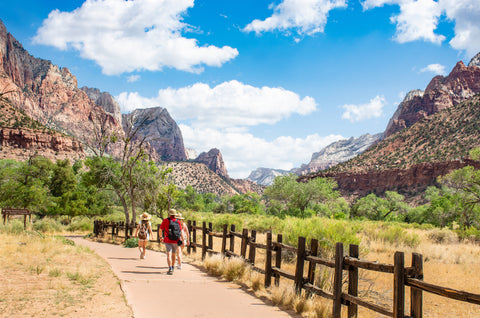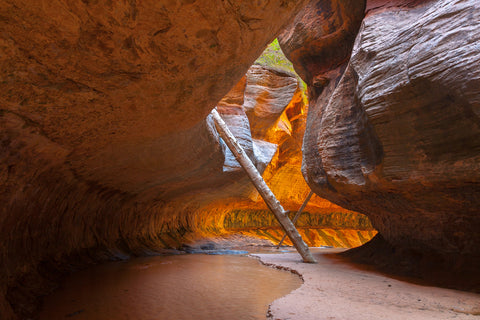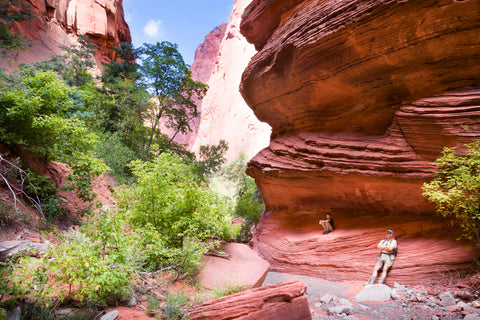Where is Zion National Park
Located in the southwest corner of Utah, just outside the city of Springdale, you’ll find Zion National Park. The park is famous for the steep red cliffs of Zion Canyon. Zion Canyon Scenic Drive bisects the park. The Virgin River snakes through Zion, leading to the Emerald Pools, an eden-like area with waterfalls and hanging garden. The park rests at the junction of the Colorado Plateau, Great Basin, and Mojave Desert regions. Zion National Park is less than an hour’s drive from St. George, Utah.

How Big is Zion National Park
Zion National Park protects 229 square miles of gorgeous scenery, wildlife and remarkable archaeological sites. Zion Canyon is 15 miles long and roughly 2,640 ft deep. The park features two significant geological arches, Crawford Arch and Kolob Arch. Coalpits Wash is the park’s lowest point at an elevation of 3,666 feet. Zion’s highest peak is Horse Ranch Mountain, topping out at 8,726 feet. Zion National Park features four distinct life zones with different flora and fauna: coniferous forest, desert, riparian and woodland.
Zion National Park Weather
The weather in Zion on average is hot and dry. However, each season brings special conditions and weather. The temperature between night and day can differ up to 30°F. The days are starting to get longer in spring, March and April. Snow is melting and the river rises. Cacti bloom and animal activity springs to life. Summer is sweltering, with temperatures exceeding 100°F. May through September is the busiest time. Fall, October and November, is much cooler. The canyon ripples with autumn color changes. It’s a good time to visit if you want to avoid the crowds. Winter is December through February. It is cold and wet in the canyon. Days peak at 60°F, dropping to below freezing at night.

When did Zion become a National Park
Zion National Park is Utah’s first national park. In 1909, an executive order established Mukuntuweap National Monument, a small area of Zion Canyon. A decade later, congress established Zion National Park. Almost 2,000 years ago, Zion Canyon was home to the Anasazi people. In fact, Archeologists can look back to 6,000 B.C. at human life in Zion.

Things to do in Zion National Park
There’s more to do in Zion Canyon that can be done in a day, plus there’s a little something for everyone. Our National Park Visitors Guide outlined some of the most popular attractions below.
Angels Landing
Once named Temple of Aeolus, Angels Landing is a stunning rock formation standing over 1,400 feet tall. In 1926, a trail was cut into the rock itself. The trail leads to the top of Angels Landing and offers a 360° view of Zion Canyon.
The Narrows
The Narrows are aptly named, it is the narrowest section of Zion Canyon. You’ll navigate past crimson walls a thousand feet tall. Your path is a rocky riverbed only 20 to 30 feet wide. Hike from the Temple of Sinawava or get a permit and start from Chamberlain's Ranch.
Emerald Pools
The Emerald Pool trails will take you to three gorgeous green pools: Lower, Middle, and Upper. The trails are rated as easy, moderate, and challenging. You’ll be lead to sparkling pools and rushing waterfalls with views of Great White Throne, Lady and Red Arch Mountains.
Kolob Canyons
The Kolob Canyons are a protected and designated wilderness. They are rugged, majestic and primitive. The area features a scenic desert drive along crimson canyons, multiple viewing points, trails, canyoneering opportunities, and backpacking in the wilderness. You must have a permit for backpacking and canyoneering.
Observation Point
Reach dizzying heights for a breathtaking birds-eye view of Angels Landing and Zion National Park. To reach Observation Point you must hike a challenging 8 miles while climbing 2,300 feet. The trail is open year-round but the best seasons to go are Spring and Fall.

Riverside Walk
The Riverside Walk in Zion is stunning and suitable for all levels of hikers. Visitors walk or hike a short trail that runs along the river to take in stunning views of towering red rocks. The best time to visit is from March to October.
Animals in Zion Canyon
There are more than 400 different species of animals that call Zion National Park home, including mammals, birds, reptiles, amphibians and fish. Mule deer and wild turkeys graze in the canyon. Lizards and scorpions skitter across rocks. Porcupines, mountain lions and ringtails stalk the night.

The Subway
The Subway is one of the most unique areas in the park. It requires a permit to access. It’s as dangerous as it is beautiful. You’ll need serious hiking, climbing, rappelling and swimming skills to navigate the Subway. You can go top down or bottom up. Either way, both trailheads start on Kolob Terrace Road.
Zion National Park Webcams
Want to check the weather conditions before you head out on a hike? Maybe you just want to take in the spectacular view of the Temples and Towers of the Virgin no matter where you are. Whatever the reason, you can check the US National Park's webcams.
Canyon Overlook
Located in the Upper East Canyon, the Canyon Overlook is one of the most popular hikes in the park. It’s a short and fairly easy hike that ends with an expansive view of Pine Creek and the canyon. A must see for any first timers.
When to go to Zion National Park
Zion National Park is open all day and year-round, though some areas close seasonally through winter and early spring. The best time to visit depends on what you like and what you want to do while you’re there. Spring brings melted snow and swelling waterways. Some areas are closed due to flooding or high water. Summer is the most popular time for visitors. The skies are clear and the air is hot. The park is fully open and the crowds are thick. Fall is the best time to visit Zion if you want to hike. The air is cool, the skies are clear and the animals are about. If you are seeking solitude and serene surroundings, come during the winter.
Must-Have things to bring to Zion
When it comes to camping, hiking or adventuring, there are some key items List of Parks suggests you should always bring along. Here is a list of some of the things you should pack.
Water/Food
When you’re exploring the park, you’ll need to bring water. Brining a bottle and some backups is recommended. You can also bring a hydration filtration device. The same goes with food. You’ll need fuel to power your journey in the form of snacks and meals.
Binoculars
Get an extended view with a good pair of binoculars. Spy far off rock formations, catch a glimpse of a cougar from a safe distance, and watch rock climbers scaling the cliff sides. Your best bet is to invest in a powerful, sturdy, lightweight pair.
Park Maps
You don’t want to get lost out in the desert canyon. Though it is gorgeous, it is a dangerous place, especially at night. Prevent getting lost by bringing along a park map. It’s a good idea to have both a digital and physical copy.
Hiking Boots
Zion Canyon and the surrounding desert is hot, harsh and rocky. The trails are tricky. You’ll want to bring hiking boots to prevent cuts, bruises, sprains and breaks. The boots should be breathable and broken in. Boots that are also waterproof is a major plus.

Sturdy Water Shoes
The canyon and Virgin River offer up plenty of opportunities for watery fun. It is recommended that you bring some sturdy water shoes before getting in the water. You’ll save your feet from injury on jagged river rocks, driftwood and other debris hidden under water.
Rain Jacket and Cool Weather Layers
You’ll be surprised at the stark differences in temperature and weather at different elevations. The higher you climb the colder it gets. Bring a waterproof rain jacket to stay dry. Pack multiple layers for cool weather for warmth; just remove layers as you heat up.
Sunglasses, Sunscreen and a Hat
The desert is hot and bright. You’ll need proper sun gear to keep from burning or overheating. Sunglasses and a lightweight wide-brimmed hat are the best options. Sunscreen is also a must. Be sure to use SPF 30 or greater. Apply early and reapply often.
Bicycle
People love biking at Zion National Park. It’s one of the best ways to get around Zion. Bicycles are allowed on all park roadways and the Pa'rus Trail. Some of the most popular rides include Canyon Junction, Weeping Rock and the Zion Canyon Scenic Drive.
Small Plastic Bags
Surprise showers and thunderstorms can catch you off guard when you’re out exploring. Put belongings in that you don’t want getting wet in a bag. Small sandwich-size bags work great for things like cell phones and keys. Larger sizes are great for maps and journals.
Backlight Flashlight
Scorpions are common in the canyon. Unless you turn over rocks, you won’t spot any during the day. They come out at night when it’s cool. The best way to spot scorpions is with a blacklight. The exoskeleton of a scorpion fluoresces under ultraviolet rays.
Where to stay in Zion National Park
When it comes to finding a place to stay at Zion National Park, you won’t have to look too far. The Zion Lodge features motel rooms, cabins, and suites. These sites are popular so book well in advance. The park also has three campgrounds: South, Lava Point, and Watchman Campgrounds. There are plenty of lodging options outside the park too. Neighboring Springdale, St. George, Hurricane and Kanab have many hotels, cabins, campgrounds and rental options.
Food Nearby Zion
Zion National Park has two great options for a good meal, both are inside the Zion Lodge. Hit the Castle Dome Cafe before heading out on a hike. Grab something substantial post-hike at the Red Rock Grill. They serve American classics and hearty, healthy options. The gift shop also offers concessions. Most visitors bring along their own food and snacks.
Airports near Zion National Park
The closest flights to Zion National Park are through McCarran International Airport. McCarran is roughly 170 miles from the park in Las Vegas, Nevada. The next closest option is Salt Lake City International Airport, which is a little over 300 miles from the park. From Salt Lake, you can get on a connecting flight to Saint George or Cedar City.


